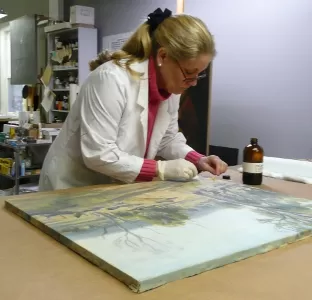Caring For Your Fine Art
by Virginia E. Newell
The fine art you own is a pleasure and an investment, and a little preventive maintenance will conserve its beauty and value for many years.
Conservation is the professional term for preventive maintenance, and implies protecting your fine art. Conservation starts with your knowledge about how to care for your art.

Restoration, which is treatment of fine art by a conservator, can arrest and in many cases reverse the negative effects of aging, accidents, and environmental damage. Restoration is only needed when something is wrong with your art. This can mean your art is dirty, torn, desiccated, acid-paper burned, fungus infected, water damaged, or any one of many other categories of damage.

The professional conservator can be thought of as a physician for your fine art. But you must take the first steps in preventing major problems and slowing the aging process.
Here, then, are some basic tips to help you conserve your fine art.
- Use your air conditioning and heating system to maintain a stable environment at a temperature between 60-70 degrees with a relative humidity between 45-60 percent.
- Keep art out of drafts and away from air conditioning and heating vents and open fireplaces in use.
- Keep art out of extended exposure to direct light, either artificial or sunlight. Hang art in shaded spots, preferably recessed.
- Never hang art on damp walls, or store in garages or in attics.
- Use only 100 percent cotton rag paper, also known as museum mounting, to mount your paper art. Only this kind of paper is acid-free.
- Consult a conservator about de-acidification of paper art, another important step in conservation.
To protect your fine art, follow these six steps — and use a conservator when necessary.
ReNewell, Inc. Fine Art Conservation 803.254.1640
This article has been republished. Original date of publication: March 4th, 2017
